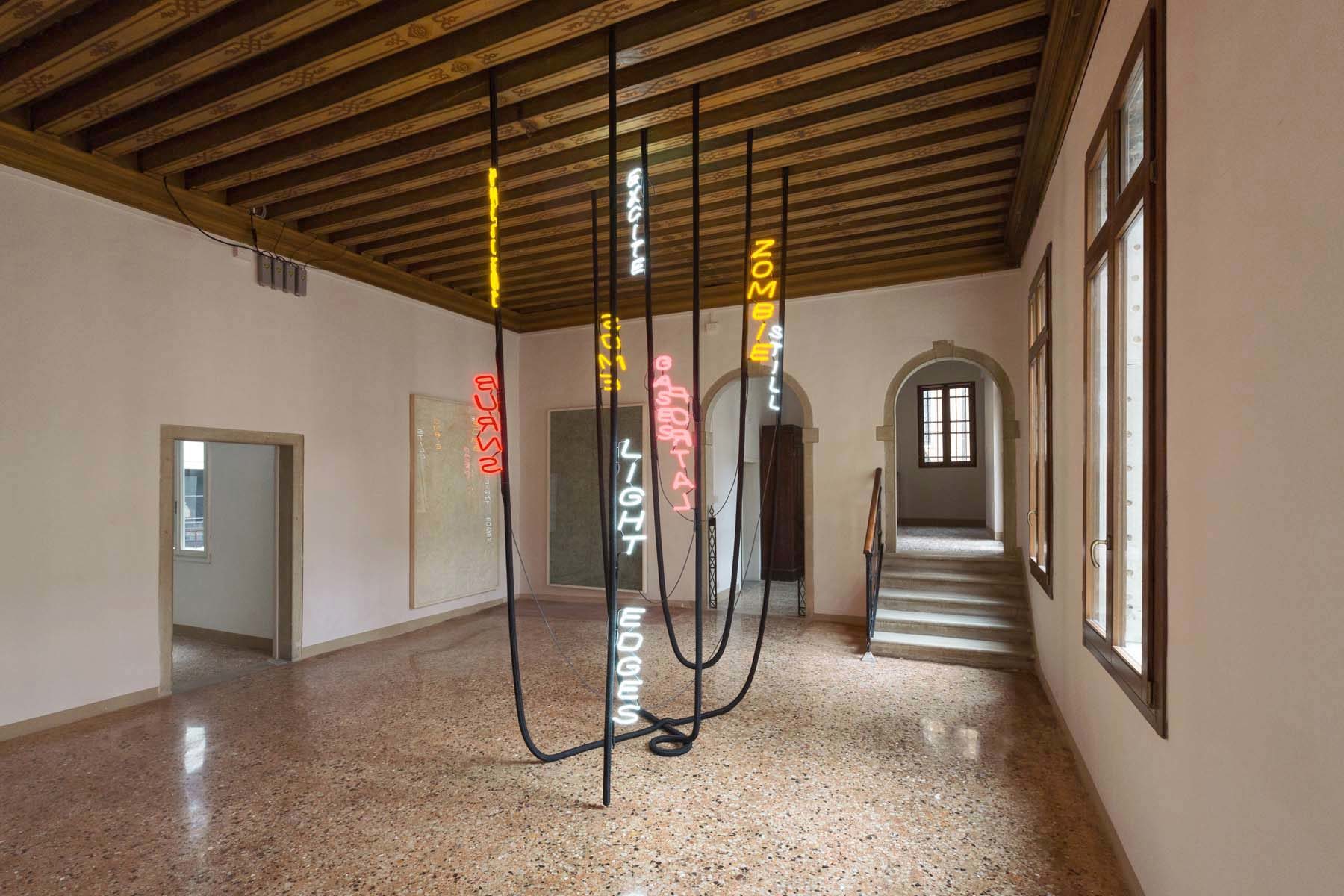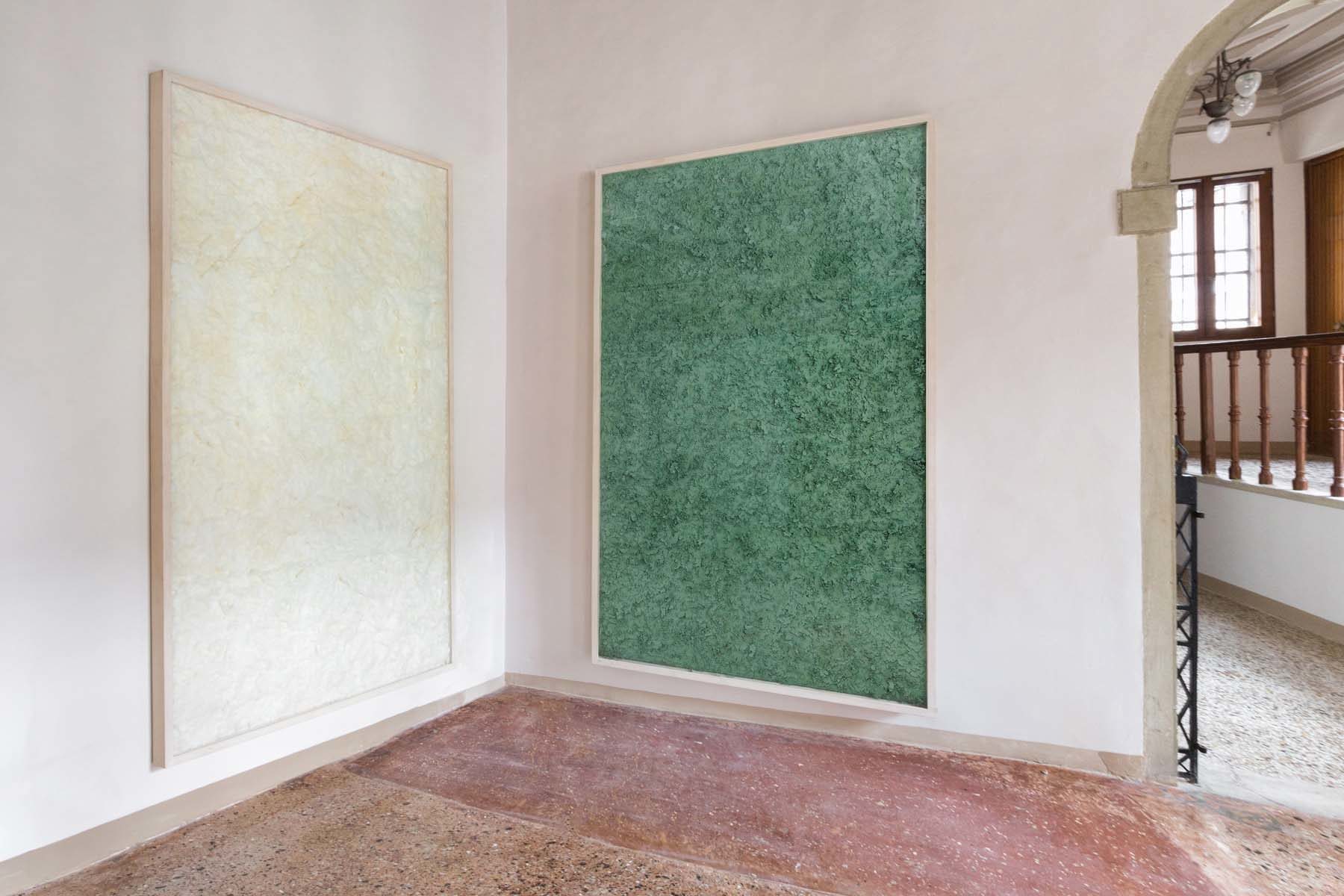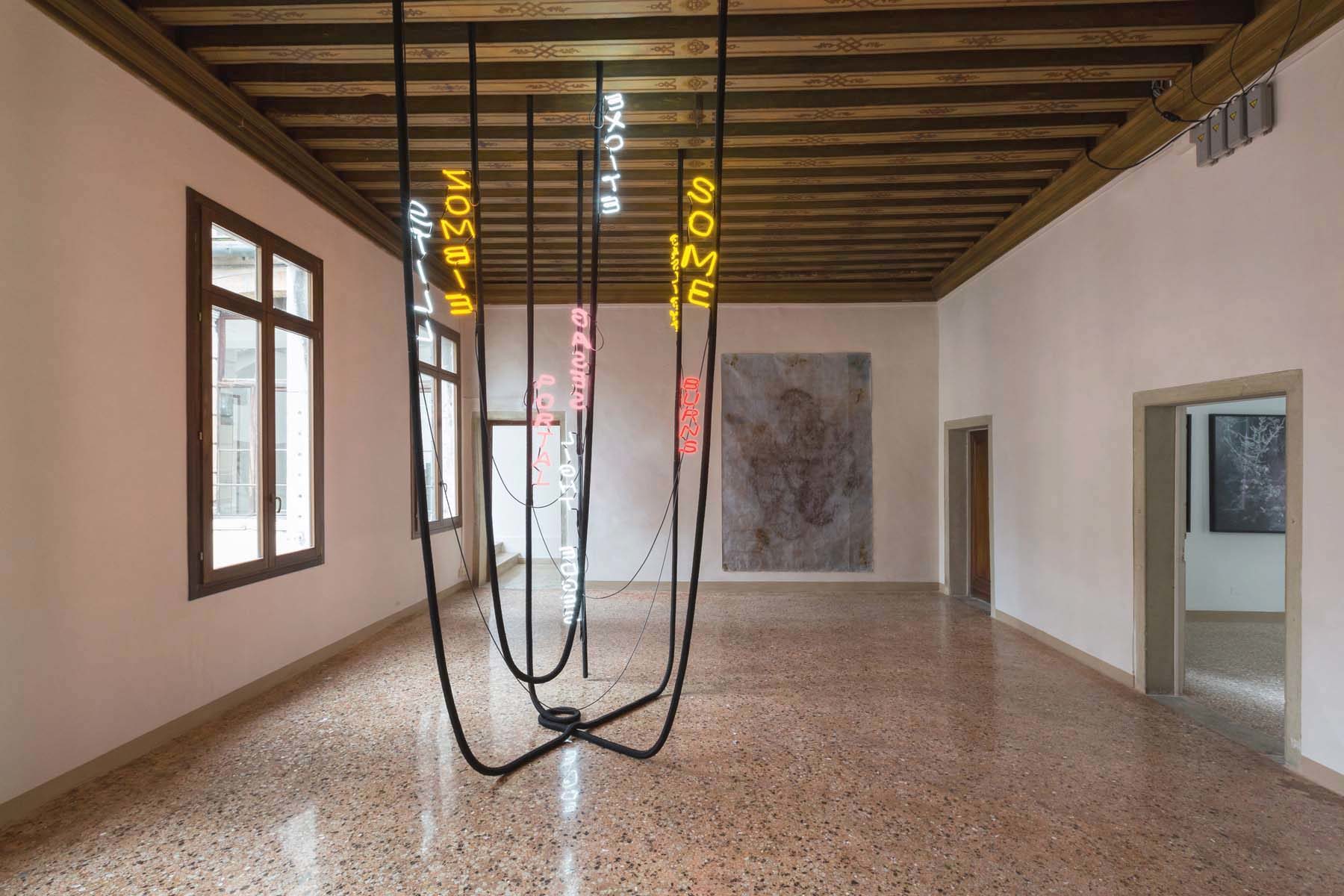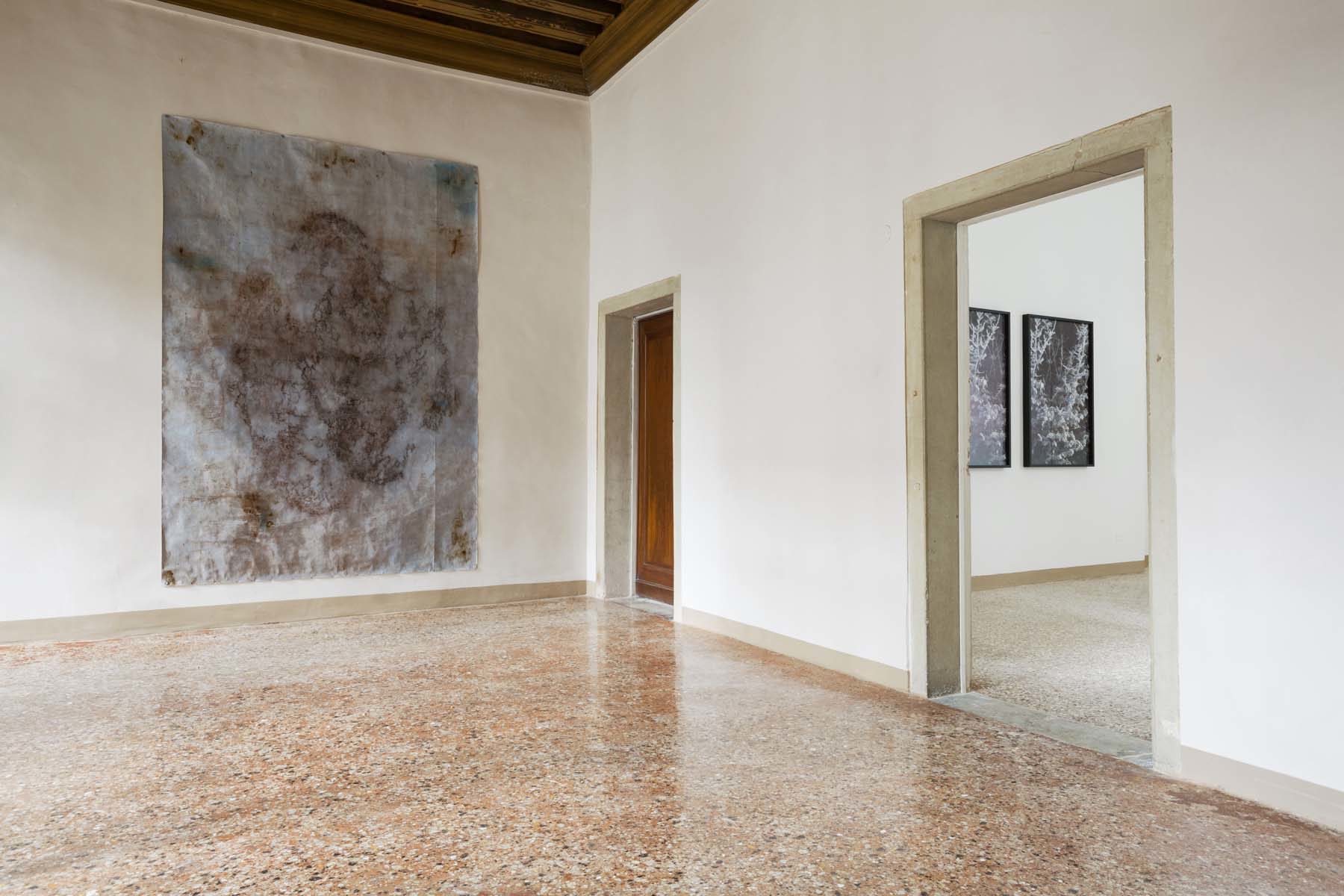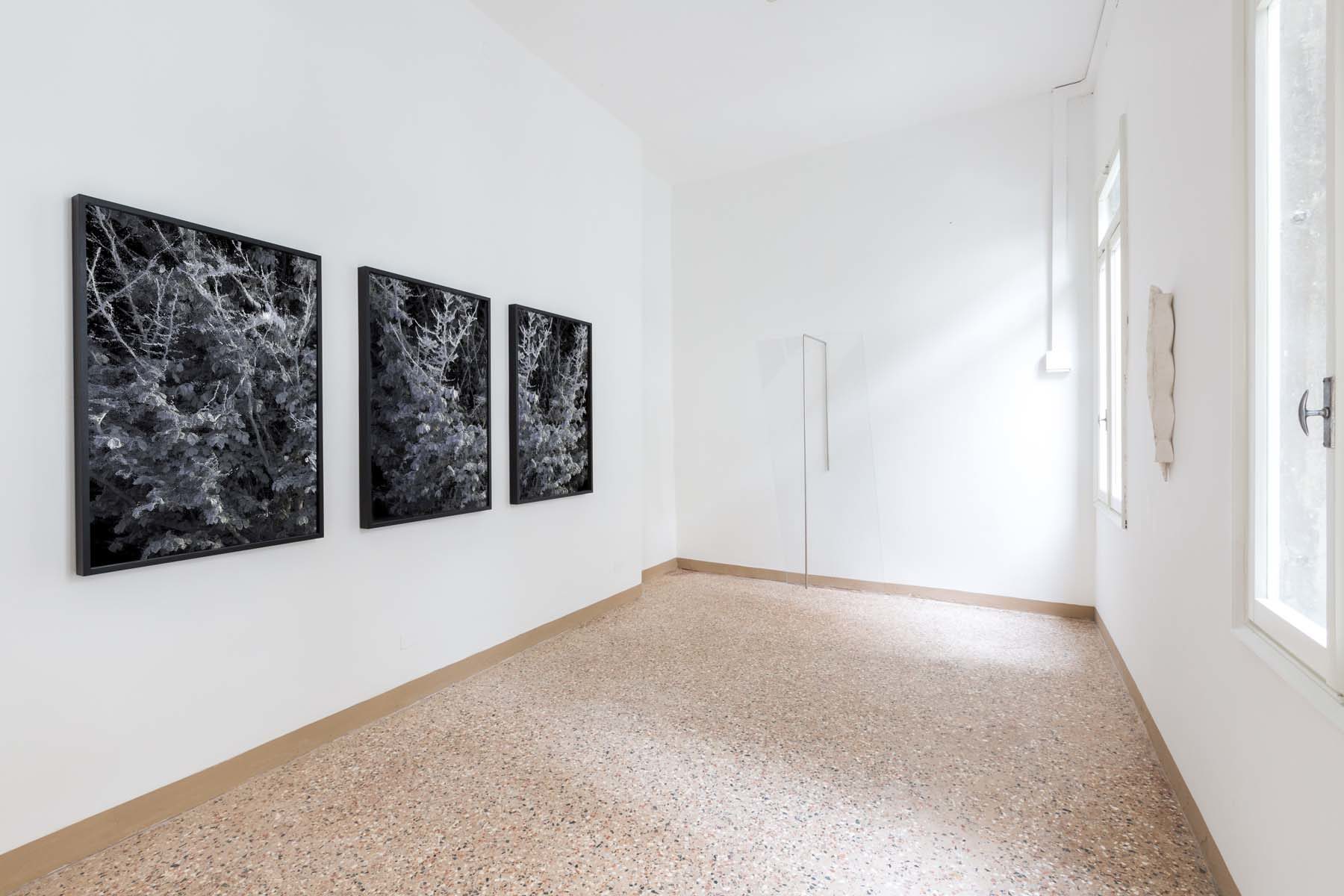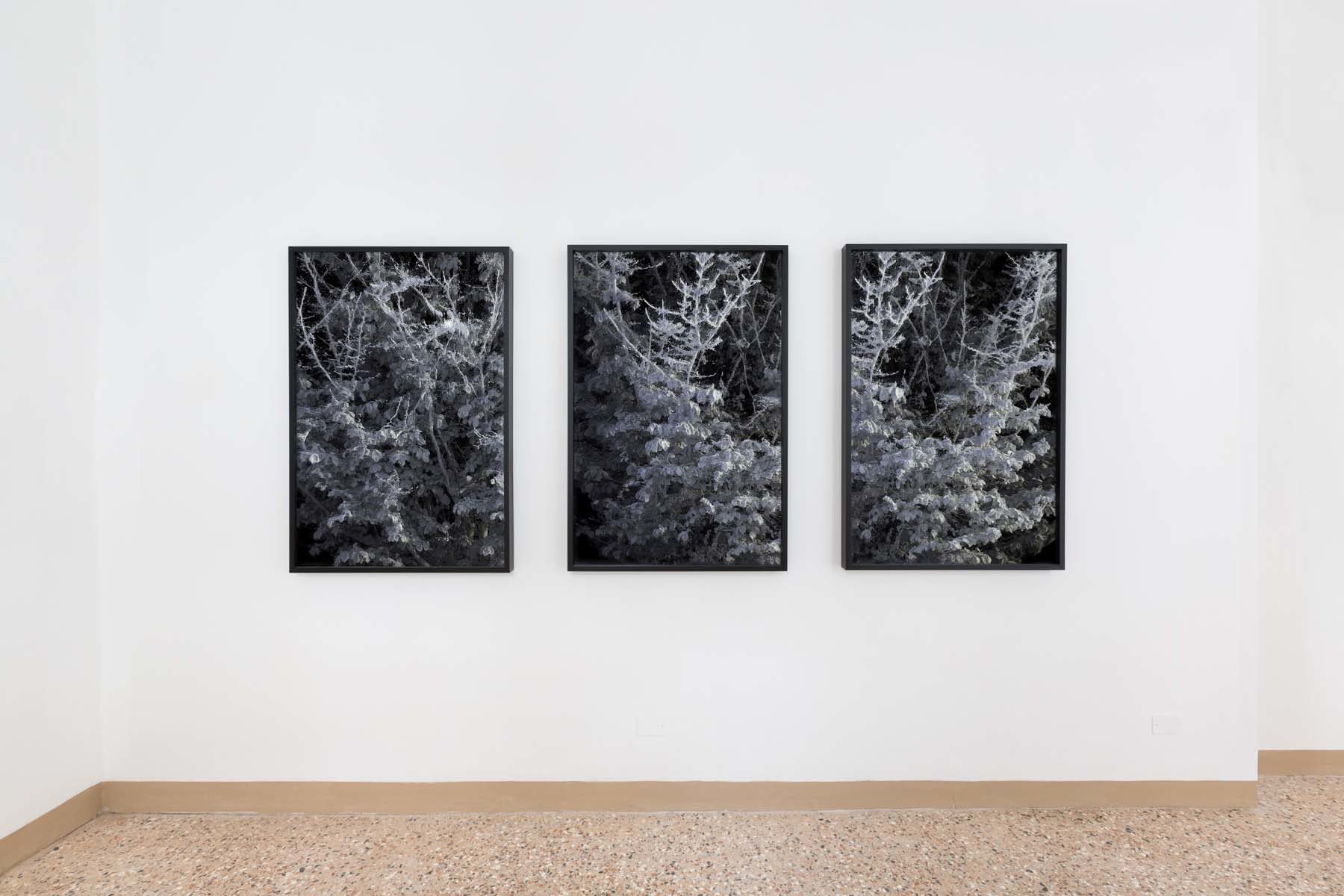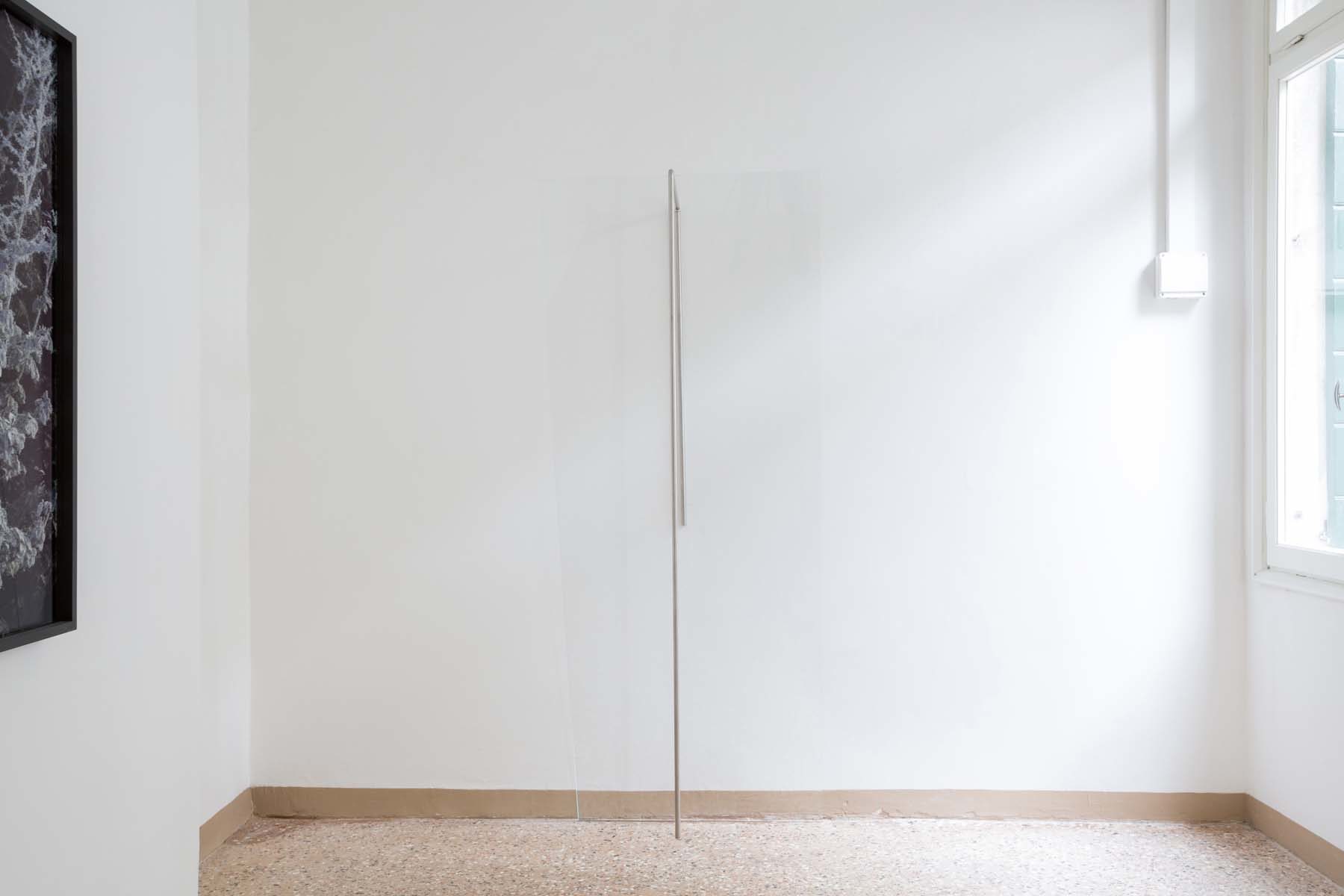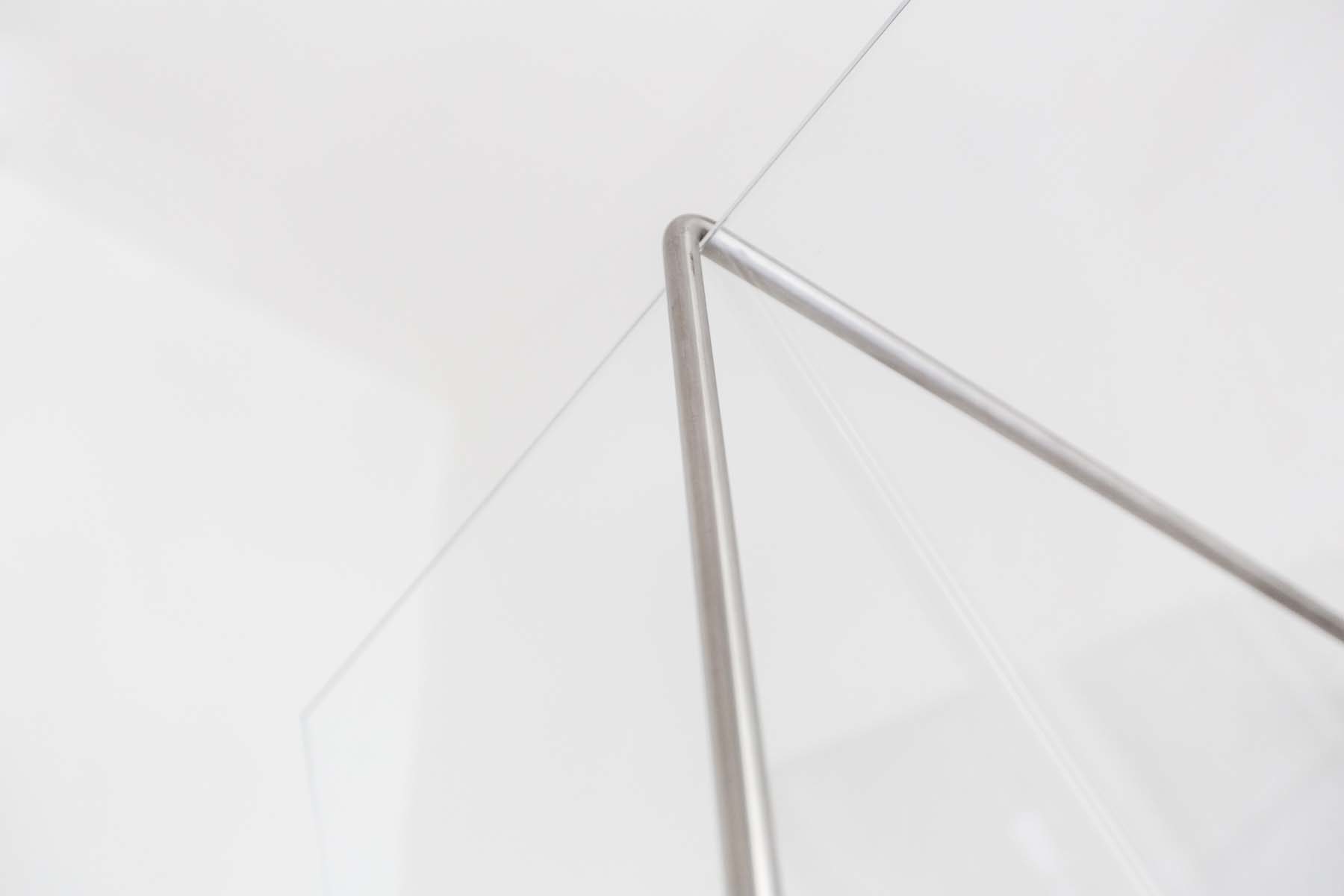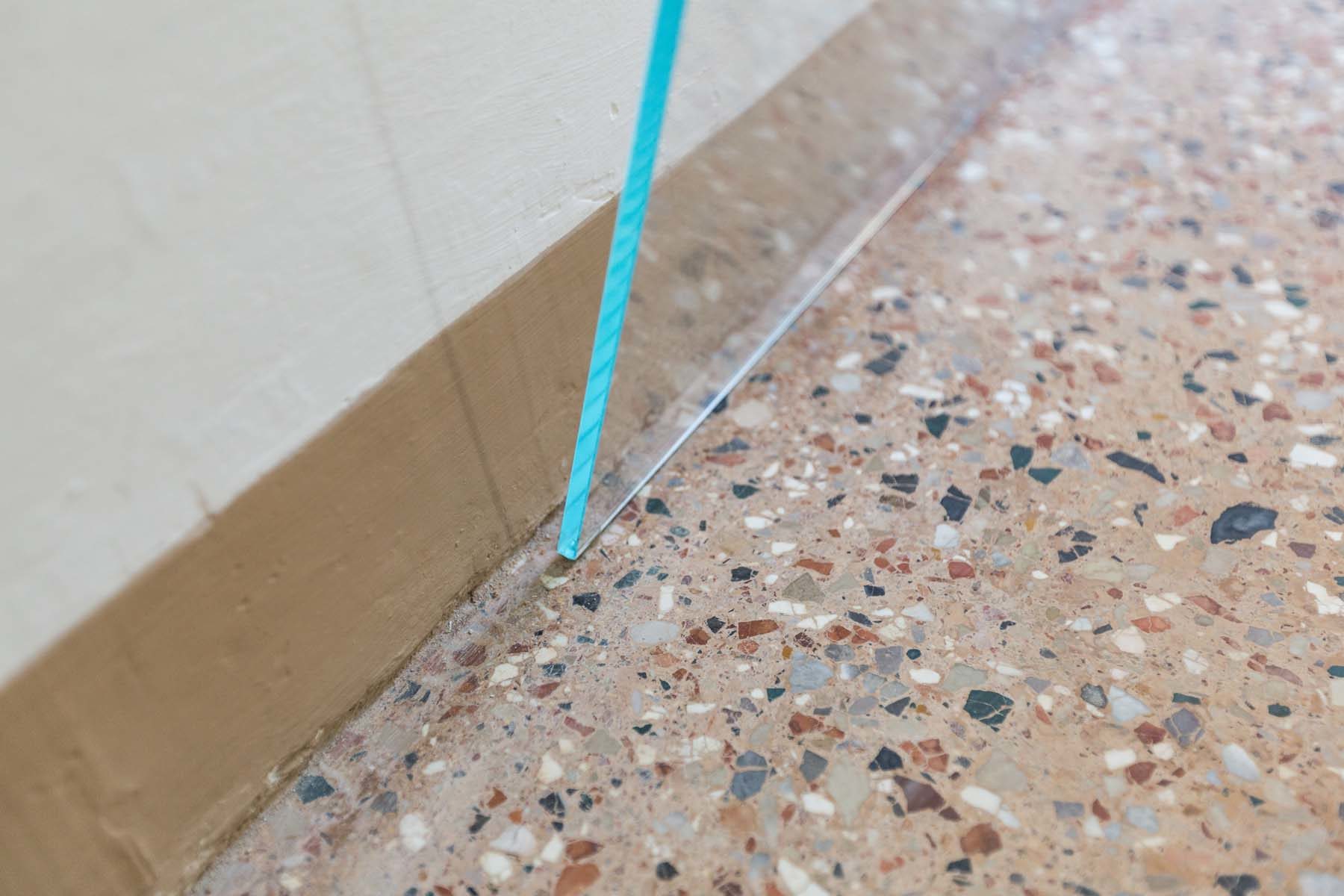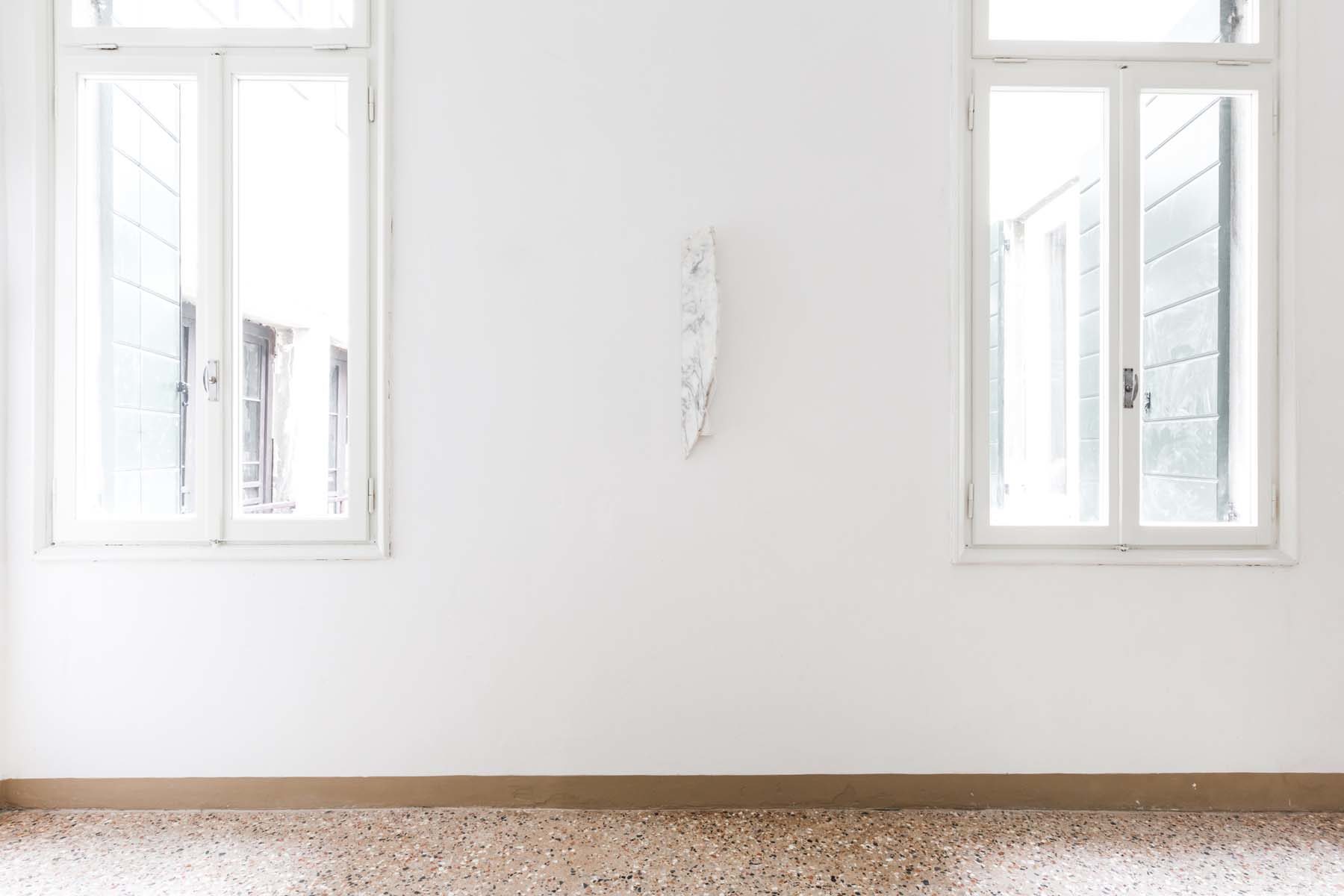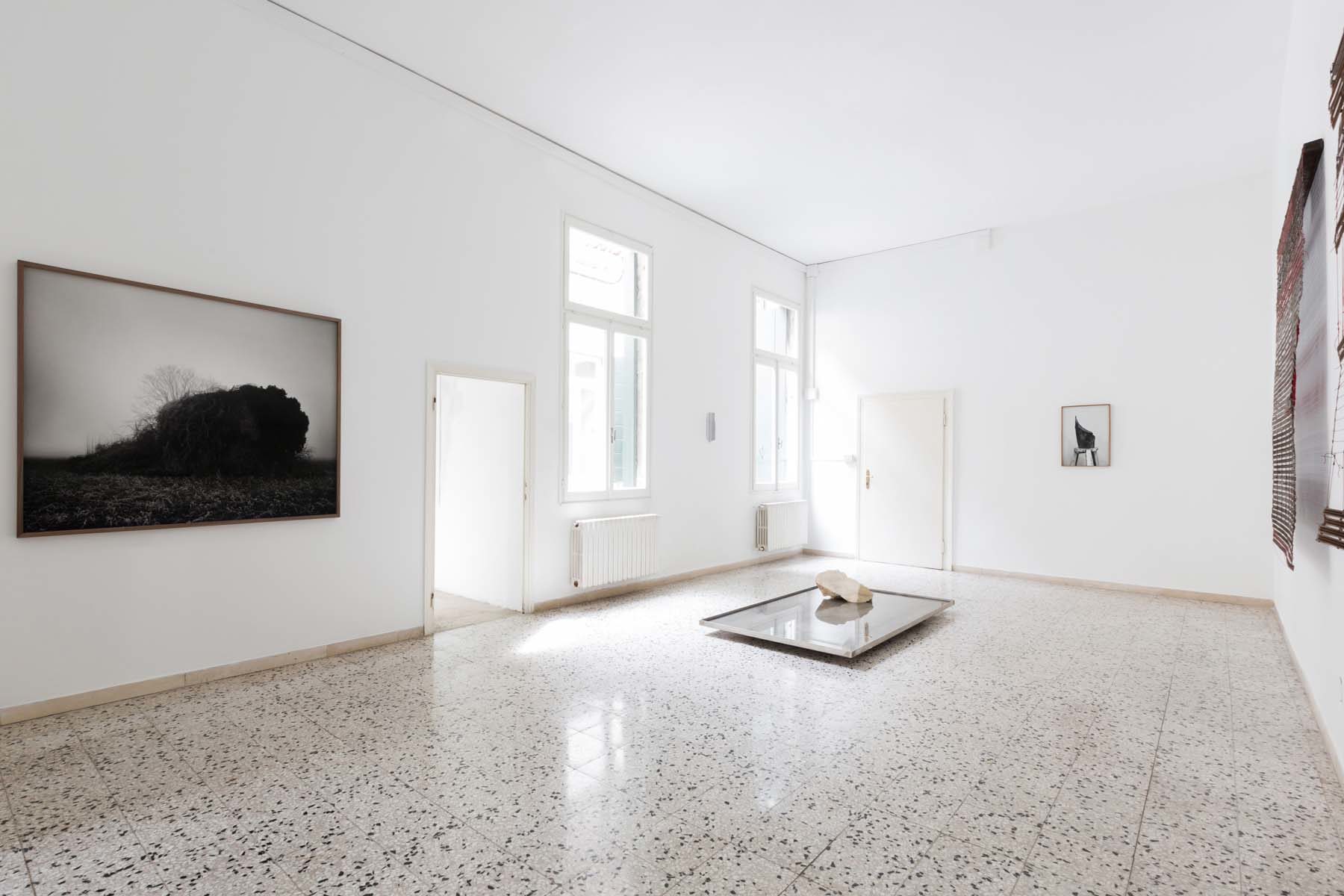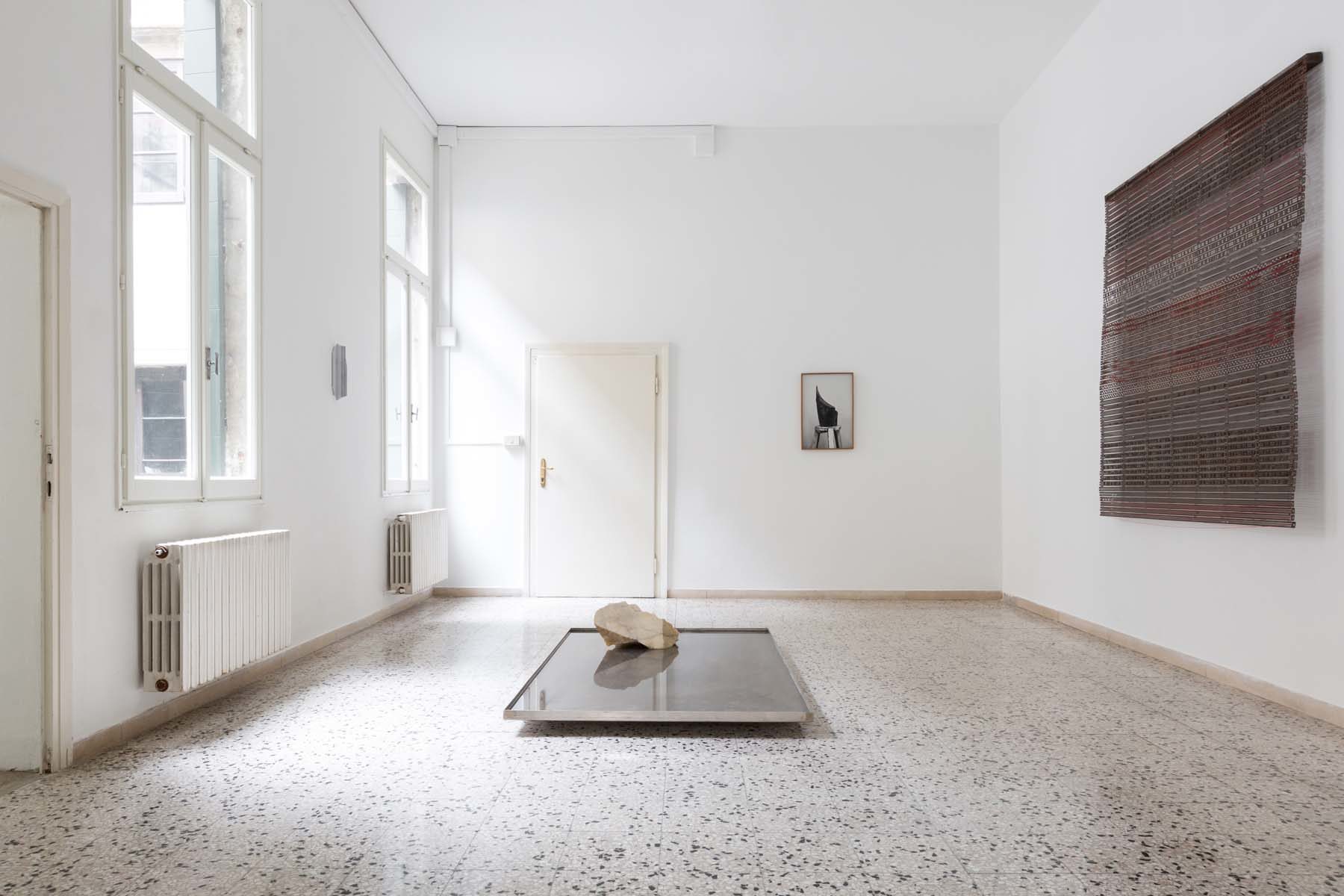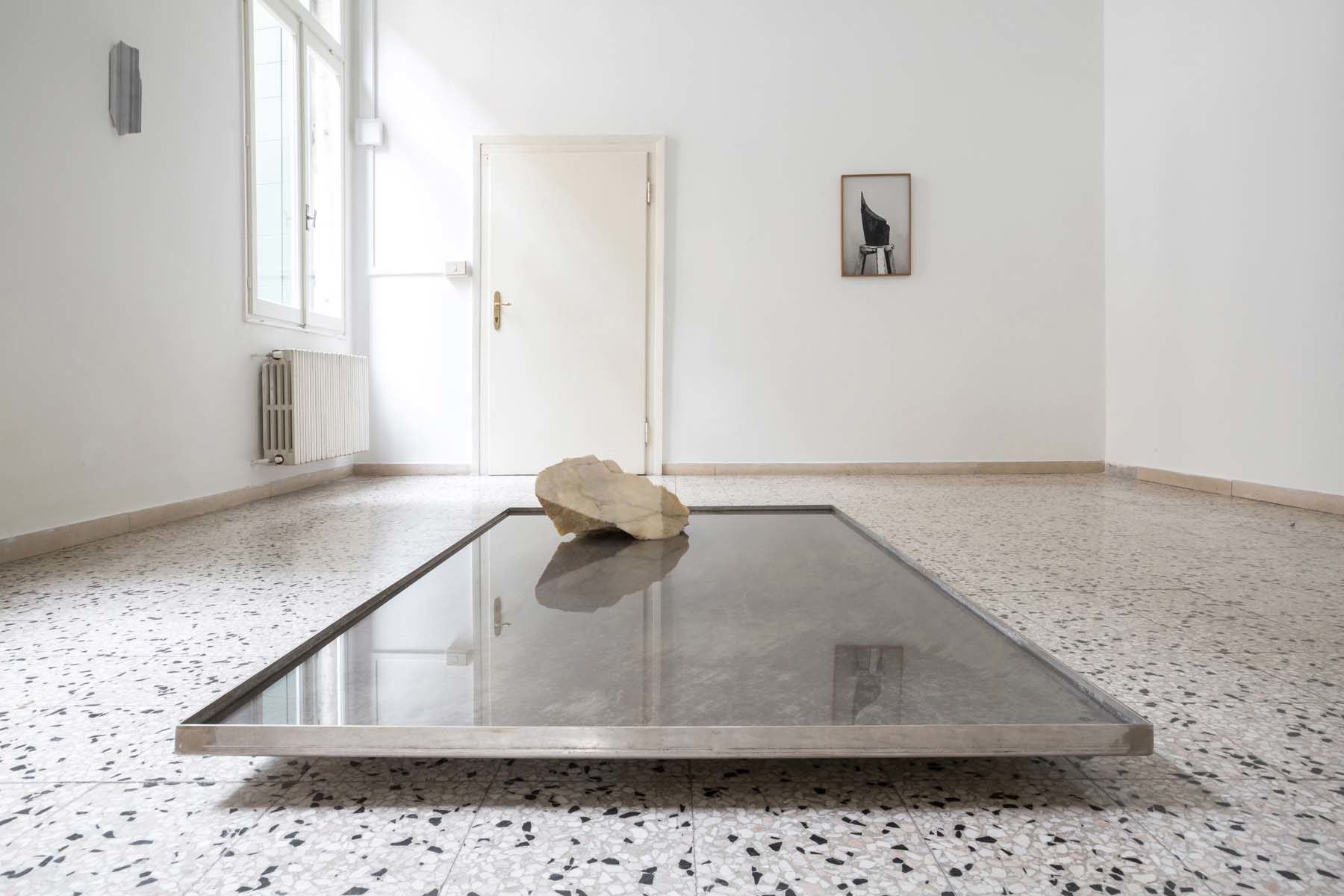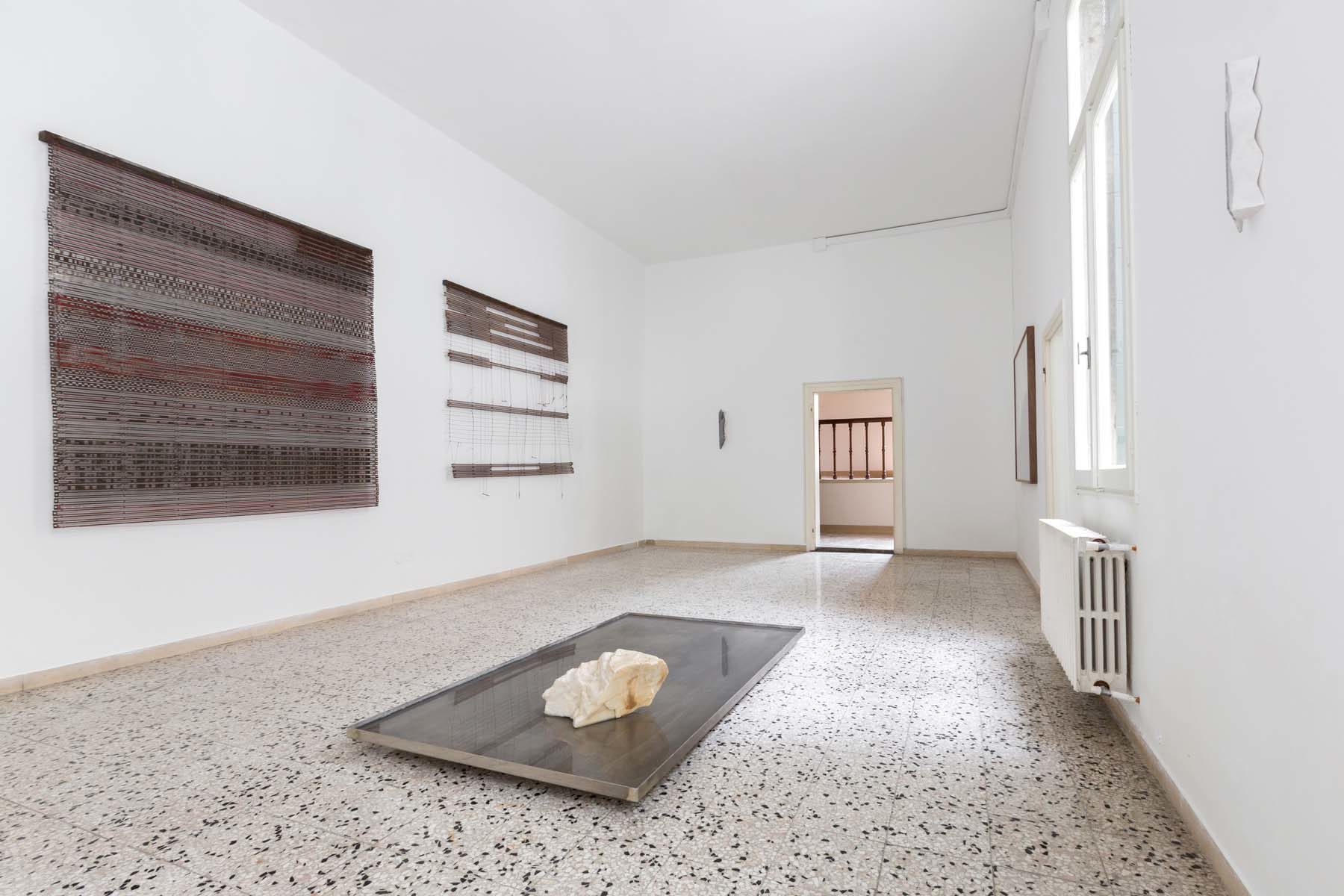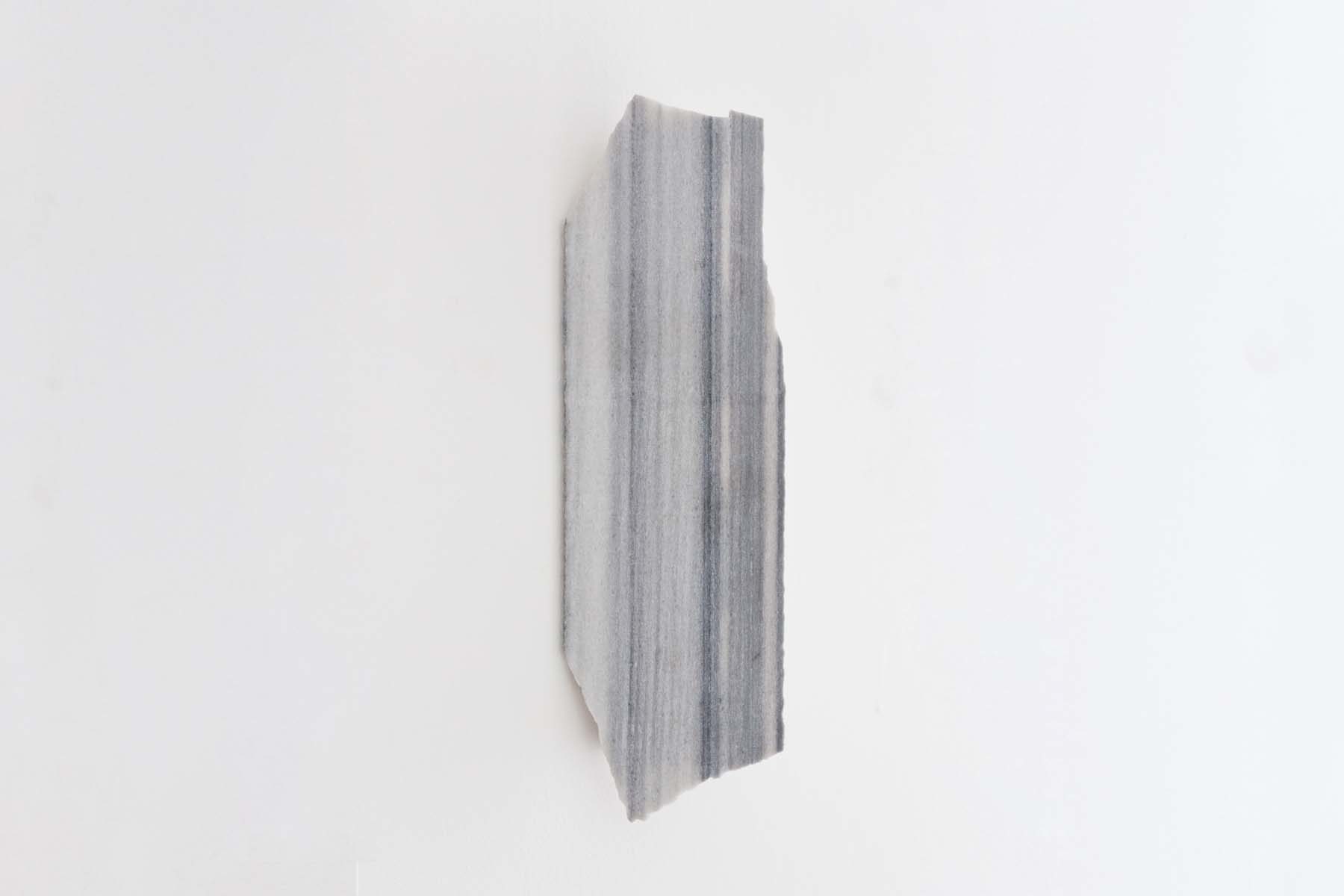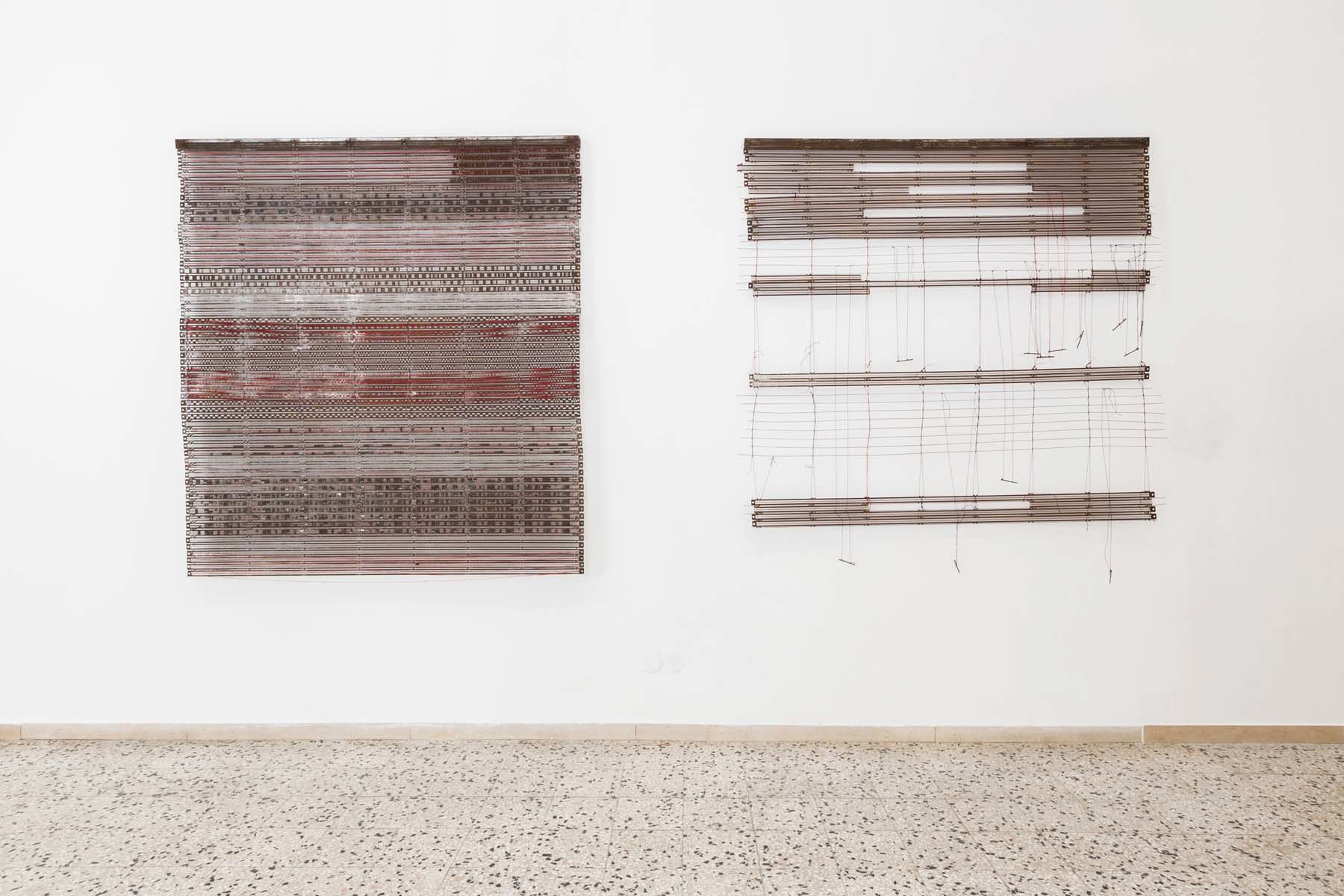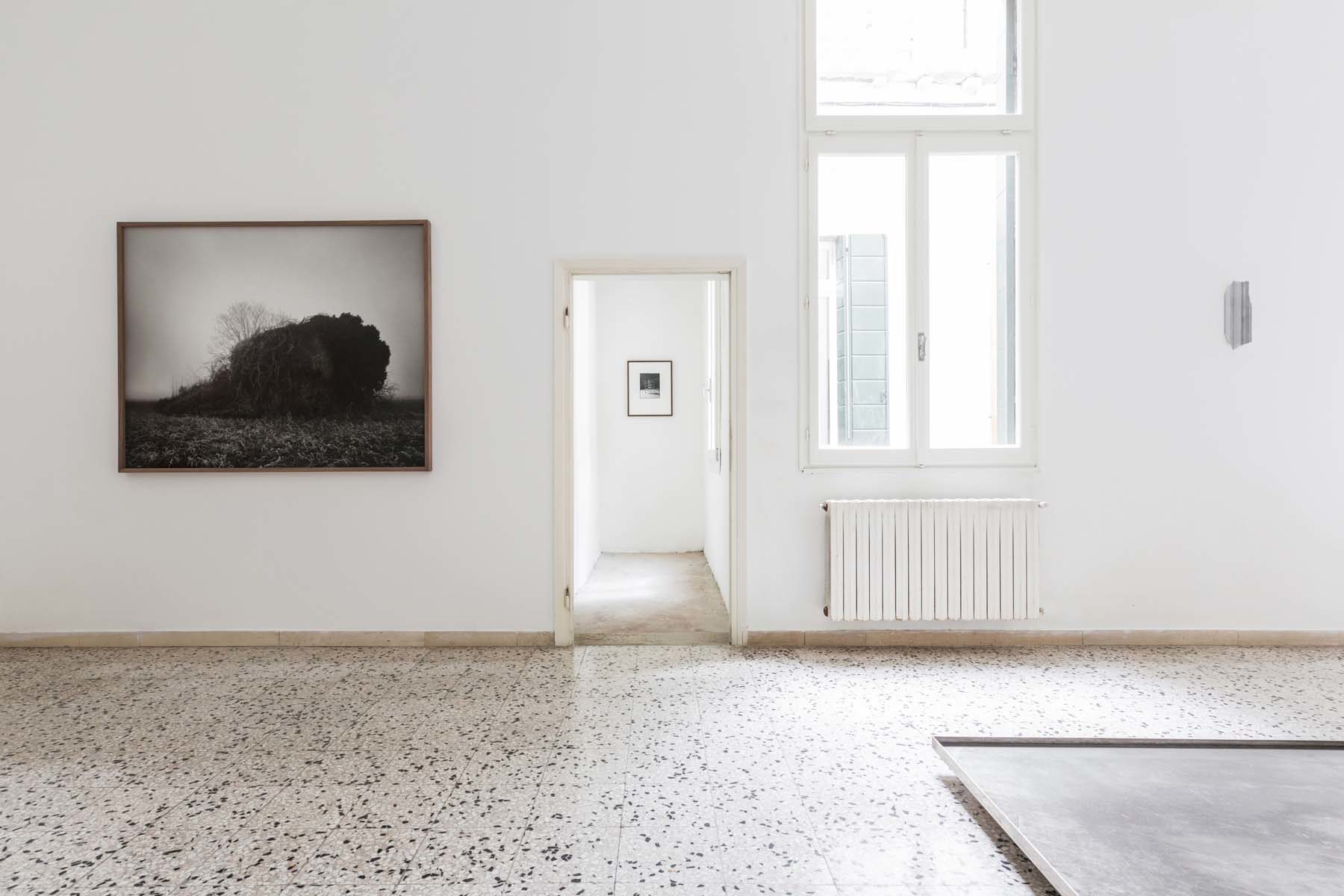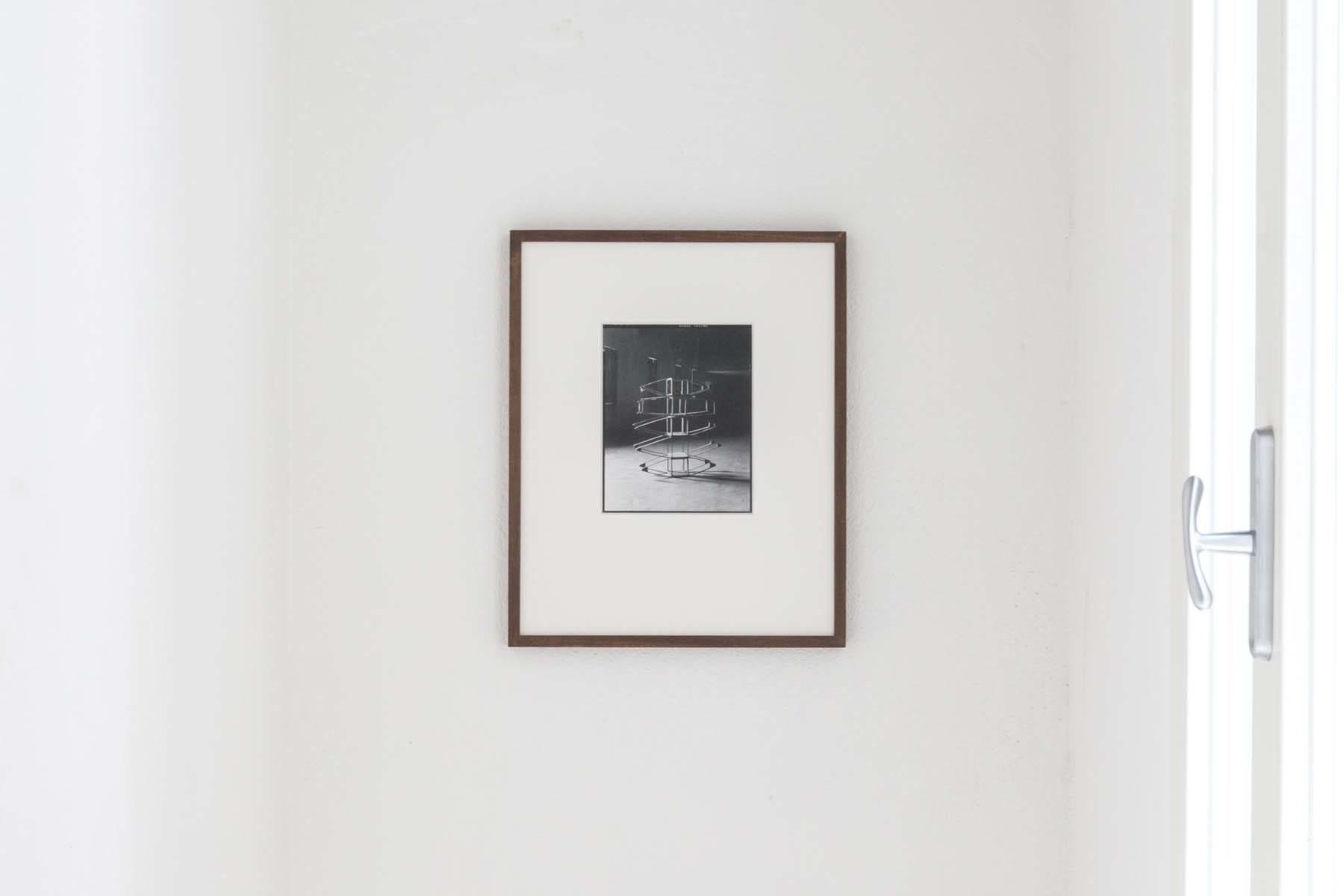Reagents
Arthur Duff, Serena Fineschi, Silvia Infranco, Túlio Pinto, Fabrizio Prevedello, Quayola, Verónica Vázquez e Marco Maria Zanin
Venice (I), Complesso dell’Ospedaletto
May ― November 2019
TextWorks
Reagents
Daniele Capra
The ability to respond to stimuli defines one aspect of life for every living being, as well as a common characteristic in terms of chemical and physical stability of any substance or material, albeit with disparities and timing that aren’t always comparable. The immersive reality we live in, the relentless flow of events that have formed our past and consequently shape our future – are the result of continuously applied dynamics of action/reaction. Whether this modality doesn’t inevitably imply a correlation of mechanistic accuracy between cause and effect, it’s certainly significant note how this ongoing negotiation between contrasting forces generates the work. In fact, the work consequently is a culmination of infinite vectors that exert forces of physical, perceptive, psychological, political and intellectual nature against the artist: the work materialises the opposite reaction and contrasts the dispersal of forces on the ground, focussing on the energy in a physically unified time and space.
Reagents gathers together eight artists whose research is characterized by a great sensibility and reactivity for the space and for the dynamics of action-reaction triggered by the environmental variables. The show highlights as in their practice the work can be seen as an apparatus generated by a process of opposition to stimuli, which is acted by the context.
The title of the exhibition refers to the renowned Isaac Newton’s third law of dynamics formulated in the Philosophiae Naturalis Principia Mathematica: during the interaction between two bodies, the force that the first body exercises on the second one is equal and opposite to the force that the second body exercises on the first one. In the same way Reagents analyses how the work can be explained as the record and the final visual result of a process, responding to the strengths that it directly perceives: the work is a factual concretization of an equilibrium which results from a continuous and constant mechanism of pushing, pulling, compressing or expanding forces.
In Chemistry, the reagent is a substance (or compound) added to a system to cause a chemical reaction, or added to test of a reaction occurs, creating a new substance. It’s a component that is introduced to fundamentally interact in some specific conditions of temperature, pressure or concentration; which is not dissimilar to what the artist can do. If we assume an anthropological and political purpose of an artist, it’s certain that she/he will be interacted with stimuli of reality – which establishes a significant trigger – as an attempt to overturn them and transform them into something else. Not simply organising them around a new subject matter, but after careful elaboration, cultivating critical tools that don’t simple articulate paraphrases/transcripts of pre-existing notions. An artist reacts when they don’t feel like adhering to the immense and fatal status quo to create an artwork, that’s uncomfortable and problematic for the viewer. Ultimately, its an apparatus facilitating an escape from the usual; the propellant leading us to a place where we couldn’t have gone, with the only strength of our own tired legs.
Daniele Capra
The ability to respond to stimuli defines one aspect of life for every living being, as well as a common characteristic in terms of chemical and physical stability of any substance or material, albeit with disparities and timing that aren’t always comparable. The immersive reality we live in, the relentless flow of events that have formed our past and consequently shape our future – are the result of continuously applied dynamics of action/reaction. Whether this modality doesn’t inevitably imply a correlation of mechanistic accuracy between cause and effect, it’s certainly significant note how this ongoing negotiation between contrasting forces generates the work. In fact, the work consequently is a culmination of infinite vectors that exert forces of physical, perceptive, psychological, political and intellectual nature against the artist: the work materialises the opposite reaction and contrasts the dispersal of forces on the ground, focussing on the energy in a physically unified time and space.
Reagents gathers together eight artists whose research is characterized by a great sensibility and reactivity for the space and for the dynamics of action-reaction triggered by the environmental variables. The show highlights as in their practice the work can be seen as an apparatus generated by a process of opposition to stimuli, which is acted by the context.
The title of the exhibition refers to the renowned Isaac Newton’s third law of dynamics formulated in the Philosophiae Naturalis Principia Mathematica: during the interaction between two bodies, the force that the first body exercises on the second one is equal and opposite to the force that the second body exercises on the first one. In the same way Reagents analyses how the work can be explained as the record and the final visual result of a process, responding to the strengths that it directly perceives: the work is a factual concretization of an equilibrium which results from a continuous and constant mechanism of pushing, pulling, compressing or expanding forces.
In Chemistry, the reagent is a substance (or compound) added to a system to cause a chemical reaction, or added to test of a reaction occurs, creating a new substance. It’s a component that is introduced to fundamentally interact in some specific conditions of temperature, pressure or concentration; which is not dissimilar to what the artist can do. If we assume an anthropological and political purpose of an artist, it’s certain that she/he will be interacted with stimuli of reality – which establishes a significant trigger – as an attempt to overturn them and transform them into something else. Not simply organising them around a new subject matter, but after careful elaboration, cultivating critical tools that don’t simple articulate paraphrases/transcripts of pre-existing notions. An artist reacts when they don’t feel like adhering to the immense and fatal status quo to create an artwork, that’s uncomfortable and problematic for the viewer. Ultimately, its an apparatus facilitating an escape from the usual; the propellant leading us to a place where we couldn’t have gone, with the only strength of our own tired legs.
The works
Daniele Capra & Ludovica Matarozzo
Arthur Duff
The essentially sculptural and installative practice of Arthur Duff is characterised by a remarkable sense of freedom, whether that be based on the materials he uses, often from a non-artistic sphere, or the firm dialogue established contextually. Regularly his work derives from the research into a relationship and a form of intimacy, which the artist expresses in the space using text, neon or laser technology.
The series of work titled Scattered Edges, applies the Japanese art form, haiku – each consisting of one or just a few isolated, freely placed words in neon colours. Vertically arranged dark rods hang the syllables from the ceiling using dark ropes, resembling lianes in a tropical rainforest. Yet, the words seem isolated and as a result, it’s difficult to construct a finished statement. The viewers’ senses confront a parchment palimpsest where important sections of text are missing, whereby one still has the ability to outline slight references from unsystematic semantic universes. The words in this work lose their primary function to be merely a sound and visual suggestion, where it’s impossible to rediscover any trance of meaning.
Serena Fineschi
The artwork by Serena Fineschi derives from an interest in the matter, in the constitutive elements of making art, as well as in fugacity and constantly changes of existing. Her works, mainly two-dimensional, explore the boundary between the procedural and conceptual practice, with an emphasis ranging from melancholic to pervasive irony.
Thirty Winter Nights (from Bruegel’s Sky to Bosch’s Garden) is the culmination of research by the artist on Flemish oil painting, which particularly focussed on how the interactions between light and surface of paintings condition our retinal colour perception. Thus, Fineschi chose to intensify the dimensional landscape of the surface with depressions created by the use of glass wool and coloured cardboard abraded like raw materials. Resulting in a distinctive three-dimensional form, where before the viewers eyes the chromatic material vibrates and moves, as if under a microscope with the original detail of the painting ten-fold enlarged. However, simultaneously the work is an apparatus that draws the attention of the audience to traces of landscapes found in five-century old paintings: a conceptual window though which colour snippets enter, that reveals a dense sky and forest bursting with light.
Silvia Infranco
The artistic practice of Silvia Infranco concerns the strong bond with organic matter that is utilized to examine the phenomena of change, memory and time. Frequently her works are conceived as a continuous accumulation, removal, maceration and stratification of components, in an incessant process where the remained slight and delicate traces encourage introspection.
The use of pounce paper (a particularly resistant media) shaped the series titled, Porifera – Metaforma, where organic and mysterious forms attempt to emerge, seeking to prevaricate thin layers of matter that compose the artwork, and encourage them to surface. The artistic process that establishes this work is a lengthy and precise procedure: the artist creates a primary form, following up with a pouncing process that is replicated in various areas of the paper, producing small holes which reveal the underlying surface. This bestows a feeling of confrontation with a living organism, perpetually expanding and willing to embrace or perhaps overwhelm us. Subsequently, the attained shape is hidden by layers of oxide, bitumen and wax; thus, embodying a dense and material fog. The spectator is called upon to stop and observe the work, as well as investigate and solve its concealed enigma. In the hope that concurrently we reveal our own hidden truths.
Túlio Pinto
The quest for balance between conflicting forces is one of the primary poetic elements in the works of Túlio Pinto. In fact, the artist explores the concept of tension by using materials that are distinguished by opposite natures and behaviours. He tests the allowed technical limits thanks to an accurate understanding of their physical properties. He attempts to challenge the matter and show the viewer how often our perceived limits are a result of inaccurate perception that can be overcome.
Rectangle #2 comprises of a large transparent sheet of glass, centrally held in place by a steel rod that is anchored to the wall. Notably, the glass is entirely held in place by the balance of natural forces and friction between the materials, preventing the base from moving across the floor. The work embodies the precariousness; a potential risk which sooner or later encourages the viewer to stop and wait for something to happen. Can metal withstand the force of gravity? Can the glass withhold the strain? Thus, Rectangle #2 can be considered as an apparatus that cultivates doubt, uncertainty and the sense of temporariness. Alongside the unceasingly discontented desire of hearing glass shatter into a thousand pieces.
Fabrizio Prevedello
Fabrizio Prevedello is exclusively devoted to sculpture, employing in a poetic and anti-rhetorical form primary materials, such as plaster, marble and metal. His practice mainly concerns the exploration of landscape and the search for an almost intimate relationship with the materials, often scrap, picked up from quarries or forgotten contexts. The artist produces sculptures with a true and sincere form of care, motivating a reaction by removing the sense of abandonment from the matter.
Descending from a mountain quarry inside a backpack (thinking of Carlo Scarpa thinking of Constantin Brancusi) consists of one rock retrieved from a cave in the Apuan Alps, which the artist subsequently transported to the valley and placed in an artificial body of water. According to the artist, marble isn’t a meek material – it comes from a sincerely respectable section of the mountain, naturally triggering reflections in its metamorphic generative force. On it actually, the twentieth century art and architecture connotations join, which Prevedello transfers introspectively as a recurring thought, from which it is difficult to get away from.
The works from the series Start drawing, kid! (keep going), were created using fragmented pieces of marble slabs, which conceal a small Brancusian plaster column of plaster – a sort of hidden conceptual matrix, that can only be seen from the side. The title refers to an old sculptor with whom he collaborated with at the beginning of his career and who used to insistently address him with this warning.
Quayola
The research of Quayola is based on the use of software, computer functions and algorithms, through which he breaks down forms and images that derive from reality or other artworks that belong to our imagination. These inspirations are subsequently digitally reformulated and thereafter, transposed into a two-dimensional or sculptural form. Within his investigation, the tensions between real and artificial, old and new, figurative and abstract, explode demonstrating the inefficiency of the taxonomies with which we usually regulate the world.
Remains is a series that begun with an observation in nature, of nature. Quayola follows in the footsteps of past artists, by positioning himself in front of a natural landscape, determined to capture the aesthetic essence. Instead of a brush, he uses a high-precision laser analysis that can scan every leaf, branch and tree-trunk of the surrounding environment with detailed precision. This work resolves the well-established conflict between nature and technology: Quayola harnesses the technological medium as a tool for detailed knowledge of the natural environment, with the ability to emphasise specific articulations and lines of force. As suggested in the title, the works represent remnants, the continued existence of a natural environment that refuses to be overpowered by technology, but rather embraces it and is enhanced by it. Furthermore, nature is placed in a condition whereby the vital life force can be released.
Verónica Vázquez
Verónica Vázquez frequently works with discarded industrial materials – including metal, leather and plastic – which she combines into striking poetic assemblages, employing a technique that reiterates manual gestures. In her work, it is possible to capture echoes of textile art and modernist sculpture combined with a very personal compositional sensitivity, where even the smallest fragment finds its intimate reason for being.
Works of the Textil series are a result of a casual and spontaneous encounter between the artist and the subject. Vázquez frequently explores industrial spaces in search of abandoned and forgotten materials, including scrap pieces of metal, unfinished products, screws or nails, that have all fallen into the abyss but are recovered by the artist herself. Thus, the artist is taking control over their existence, saving them from a slow process of disappearance and giving them new life. As a result, the metal pieces leave behind their original context – linked to industry, technology and intensive procedure – to attain the new condition of an artwork, a slow and immobile dimension linked to tradition. The metal becomes an unexpected tool to weave with and the artist created sparkling and sharp tapestries, that are delicate but aggressive. The rough metal material, despite softened by its charming assemblage, preserves its primordial power. Plus, as a geometric composition the spectator can still hear the distant echoes of Vulcan’s Forge.
Marco Maria Zanin
The works by Marco Maria Zanin originate from a visual interest in landscape, the remains of anthropogenic interventions, as well as the physical and symbolic legacies of rural civilisation, which he investigates using photography. His research starts from an anthropological approach and the comparison of old times, conventions and modalities of which he highlights the incompatibility, as accentuated often by the images of artefacts that no longer have a function.
The series titled Cattedrali rurali originated from a study carried out in the Venetian countryside, searching for residual architectural structures that were abandoned or are no longer in use – including ruins of houses, rural storages, small bridges or boundary walls. These res derelicta are untended buildings, that in the past used to support life and have a productivity purpose; but now they don’t have any function anymore and they are simply a theatrical background; a hazy background which nature is staged instead, as a continuously evolving form.
Arzanà and Magic Religious Figure are traces of objects of a past time. The latter depicts metal furnishings that, until the middle of last century, were used to heat beds with hot stone. Moreover, their presence is generally quite disturbing, almost a fetish of sorts. Or perhaps, they demonstrate all ties that we’ve lost with our ancestors, who appear at our front doors, as a sudden and cumbersome presence.
Daniele Capra & Ludovica Matarozzo
Arthur Duff
The essentially sculptural and installative practice of Arthur Duff is characterised by a remarkable sense of freedom, whether that be based on the materials he uses, often from a non-artistic sphere, or the firm dialogue established contextually. Regularly his work derives from the research into a relationship and a form of intimacy, which the artist expresses in the space using text, neon or laser technology.
The series of work titled Scattered Edges, applies the Japanese art form, haiku – each consisting of one or just a few isolated, freely placed words in neon colours. Vertically arranged dark rods hang the syllables from the ceiling using dark ropes, resembling lianes in a tropical rainforest. Yet, the words seem isolated and as a result, it’s difficult to construct a finished statement. The viewers’ senses confront a parchment palimpsest where important sections of text are missing, whereby one still has the ability to outline slight references from unsystematic semantic universes. The words in this work lose their primary function to be merely a sound and visual suggestion, where it’s impossible to rediscover any trance of meaning.
Serena Fineschi
The artwork by Serena Fineschi derives from an interest in the matter, in the constitutive elements of making art, as well as in fugacity and constantly changes of existing. Her works, mainly two-dimensional, explore the boundary between the procedural and conceptual practice, with an emphasis ranging from melancholic to pervasive irony.
Thirty Winter Nights (from Bruegel’s Sky to Bosch’s Garden) is the culmination of research by the artist on Flemish oil painting, which particularly focussed on how the interactions between light and surface of paintings condition our retinal colour perception. Thus, Fineschi chose to intensify the dimensional landscape of the surface with depressions created by the use of glass wool and coloured cardboard abraded like raw materials. Resulting in a distinctive three-dimensional form, where before the viewers eyes the chromatic material vibrates and moves, as if under a microscope with the original detail of the painting ten-fold enlarged. However, simultaneously the work is an apparatus that draws the attention of the audience to traces of landscapes found in five-century old paintings: a conceptual window though which colour snippets enter, that reveals a dense sky and forest bursting with light.
Silvia Infranco
The artistic practice of Silvia Infranco concerns the strong bond with organic matter that is utilized to examine the phenomena of change, memory and time. Frequently her works are conceived as a continuous accumulation, removal, maceration and stratification of components, in an incessant process where the remained slight and delicate traces encourage introspection.
The use of pounce paper (a particularly resistant media) shaped the series titled, Porifera – Metaforma, where organic and mysterious forms attempt to emerge, seeking to prevaricate thin layers of matter that compose the artwork, and encourage them to surface. The artistic process that establishes this work is a lengthy and precise procedure: the artist creates a primary form, following up with a pouncing process that is replicated in various areas of the paper, producing small holes which reveal the underlying surface. This bestows a feeling of confrontation with a living organism, perpetually expanding and willing to embrace or perhaps overwhelm us. Subsequently, the attained shape is hidden by layers of oxide, bitumen and wax; thus, embodying a dense and material fog. The spectator is called upon to stop and observe the work, as well as investigate and solve its concealed enigma. In the hope that concurrently we reveal our own hidden truths.
Túlio Pinto
The quest for balance between conflicting forces is one of the primary poetic elements in the works of Túlio Pinto. In fact, the artist explores the concept of tension by using materials that are distinguished by opposite natures and behaviours. He tests the allowed technical limits thanks to an accurate understanding of their physical properties. He attempts to challenge the matter and show the viewer how often our perceived limits are a result of inaccurate perception that can be overcome.
Rectangle #2 comprises of a large transparent sheet of glass, centrally held in place by a steel rod that is anchored to the wall. Notably, the glass is entirely held in place by the balance of natural forces and friction between the materials, preventing the base from moving across the floor. The work embodies the precariousness; a potential risk which sooner or later encourages the viewer to stop and wait for something to happen. Can metal withstand the force of gravity? Can the glass withhold the strain? Thus, Rectangle #2 can be considered as an apparatus that cultivates doubt, uncertainty and the sense of temporariness. Alongside the unceasingly discontented desire of hearing glass shatter into a thousand pieces.
Fabrizio Prevedello
Fabrizio Prevedello is exclusively devoted to sculpture, employing in a poetic and anti-rhetorical form primary materials, such as plaster, marble and metal. His practice mainly concerns the exploration of landscape and the search for an almost intimate relationship with the materials, often scrap, picked up from quarries or forgotten contexts. The artist produces sculptures with a true and sincere form of care, motivating a reaction by removing the sense of abandonment from the matter.
Descending from a mountain quarry inside a backpack (thinking of Carlo Scarpa thinking of Constantin Brancusi) consists of one rock retrieved from a cave in the Apuan Alps, which the artist subsequently transported to the valley and placed in an artificial body of water. According to the artist, marble isn’t a meek material – it comes from a sincerely respectable section of the mountain, naturally triggering reflections in its metamorphic generative force. On it actually, the twentieth century art and architecture connotations join, which Prevedello transfers introspectively as a recurring thought, from which it is difficult to get away from.
The works from the series Start drawing, kid! (keep going), were created using fragmented pieces of marble slabs, which conceal a small Brancusian plaster column of plaster – a sort of hidden conceptual matrix, that can only be seen from the side. The title refers to an old sculptor with whom he collaborated with at the beginning of his career and who used to insistently address him with this warning.
Quayola
The research of Quayola is based on the use of software, computer functions and algorithms, through which he breaks down forms and images that derive from reality or other artworks that belong to our imagination. These inspirations are subsequently digitally reformulated and thereafter, transposed into a two-dimensional or sculptural form. Within his investigation, the tensions between real and artificial, old and new, figurative and abstract, explode demonstrating the inefficiency of the taxonomies with which we usually regulate the world.
Remains is a series that begun with an observation in nature, of nature. Quayola follows in the footsteps of past artists, by positioning himself in front of a natural landscape, determined to capture the aesthetic essence. Instead of a brush, he uses a high-precision laser analysis that can scan every leaf, branch and tree-trunk of the surrounding environment with detailed precision. This work resolves the well-established conflict between nature and technology: Quayola harnesses the technological medium as a tool for detailed knowledge of the natural environment, with the ability to emphasise specific articulations and lines of force. As suggested in the title, the works represent remnants, the continued existence of a natural environment that refuses to be overpowered by technology, but rather embraces it and is enhanced by it. Furthermore, nature is placed in a condition whereby the vital life force can be released.
Verónica Vázquez
Verónica Vázquez frequently works with discarded industrial materials – including metal, leather and plastic – which she combines into striking poetic assemblages, employing a technique that reiterates manual gestures. In her work, it is possible to capture echoes of textile art and modernist sculpture combined with a very personal compositional sensitivity, where even the smallest fragment finds its intimate reason for being.
Works of the Textil series are a result of a casual and spontaneous encounter between the artist and the subject. Vázquez frequently explores industrial spaces in search of abandoned and forgotten materials, including scrap pieces of metal, unfinished products, screws or nails, that have all fallen into the abyss but are recovered by the artist herself. Thus, the artist is taking control over their existence, saving them from a slow process of disappearance and giving them new life. As a result, the metal pieces leave behind their original context – linked to industry, technology and intensive procedure – to attain the new condition of an artwork, a slow and immobile dimension linked to tradition. The metal becomes an unexpected tool to weave with and the artist created sparkling and sharp tapestries, that are delicate but aggressive. The rough metal material, despite softened by its charming assemblage, preserves its primordial power. Plus, as a geometric composition the spectator can still hear the distant echoes of Vulcan’s Forge.
Marco Maria Zanin
The works by Marco Maria Zanin originate from a visual interest in landscape, the remains of anthropogenic interventions, as well as the physical and symbolic legacies of rural civilisation, which he investigates using photography. His research starts from an anthropological approach and the comparison of old times, conventions and modalities of which he highlights the incompatibility, as accentuated often by the images of artefacts that no longer have a function.
The series titled Cattedrali rurali originated from a study carried out in the Venetian countryside, searching for residual architectural structures that were abandoned or are no longer in use – including ruins of houses, rural storages, small bridges or boundary walls. These res derelicta are untended buildings, that in the past used to support life and have a productivity purpose; but now they don’t have any function anymore and they are simply a theatrical background; a hazy background which nature is staged instead, as a continuously evolving form.
Arzanà and Magic Religious Figure are traces of objects of a past time. The latter depicts metal furnishings that, until the middle of last century, were used to heat beds with hot stone. Moreover, their presence is generally quite disturbing, almost a fetish of sorts. Or perhaps, they demonstrate all ties that we’ve lost with our ancestors, who appear at our front doors, as a sudden and cumbersome presence.
